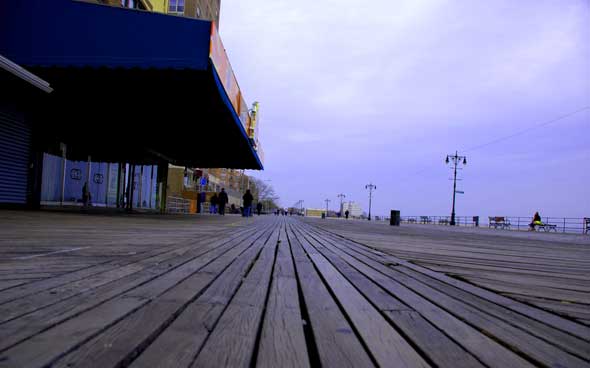Local Pols Devise Plan To Expedite Boardwalk Bike Path, Spurring Outcry From Environmentalists

YOU READ IT HERE FIRST: Legislation sponsored by local officials seeks to transfer jurisdiction over the sands of Brighton Beach and Coney Island from the state to the city, allowing them to move forward with a long delayed bicycle path. But local activists are calling foul play, saying that it undercuts stringent regulations that are in place for a reason.
Assemblyman Steven Cymbrowitz has introduced legislation to the State Assembly that would transfer 250 feet of property south of the 2.5-mile-long Riegelmann Boardwalk along Brighton Beach and Coney Island to the New York City Parks Department. Even though the Parks Department maintains the land, the state Department of Environmental Conservation has final say about work to be done there – and according to Cymbrowitz, the agency has repeatedly blocked a planned bike path that would run the length of the property.
“[Funding was allocated for a bike path] almost 8 years ago. It was done by [Assemblyman] Alec Brook-Krasny’s predecessor Adele Cohen. Alec and I have continued to ensure that it’s in the budget, and every time we attempt to work with Parks Department, DEC says no,” Cymbrowitz told Sheepshead Bites. “As part of the money that Alec and I gave for the redoing of the boardwalk several years ago, the plan was also to put additional play areas on the sand to make it more enjoyable for families and individuals. Again, DEC said no. So that’s where the legislation came from, because DEC is the agency of no.”
Cymbrowitz’s proposed legislation would wrest control from the state agency, and give the Parks Department total control of the area south of the boardwalk. It’s co-sponsored by Brook-Krasny and sponsored in the State Senate by Diane Savino.
Brighton Beach resident Ida Sanoff, executive director of the Natural Resources Protective Association, said the pols have their story all wrong, and says this is just an end-run around important regulations that keep neighbors safe.
For starters, the DEC has never rejected the request for a bike path. In fact, that request was never made, she said.
“Within the last six months I followed up with DEC. And according to DEC, the Parks Department never completed the application. And if I know this, why don’t they? There’s something very, very wrong here and no one can give me a straight answer as to what’s going on,” Sanoff said.
A DEC spokesperson told Sheepshead Bites they could not comment on pending legislation. Asked in an e-mail follow-up about the application for a bike path, the agency has not yet responded. Similarly, the Parks Department has not responded to a request for comment.
Brook-Krasny, however, said that he only recently learned that Parks may not have completed the application, and is considering withdrawing his support for the legislation, although he will still push for the bike path, he told Sheepshead Bites.
“One day we’ll have a bike path. But again, there’s a question about why that application was denied. We’ll have to look into it,” said Brook-Krasny.
The Coney Island legislator said that Sandy was also giving him second thoughts about transferring jurisdiction. When Sheepshead Bites noted that he signed onto this legislation more than six months after Sandy, Brook-Krasny reiterated his need to look over the proposal.
“With everything that’s happening after Sandy, I’m just rethinking what was done even after Sandy,” Brook-Krasny said after we pointed out the time gap. “Look, I’ve got to look into it and really think about it, and think together with Steve Cymbrowitz. The idea to have a bike path is a great idea, and I understand the application by the Parks Department was never completed. I just need to spend some more time on it. ”
According to Sanoff, the DEC’s more stringent regulations require any work on the beaches to include proper studies into erosion. She said that fixed structures – particularly hard ones made of concrete – increase the potential for erosion, and with it, the damage caused by flooding.
“There is a reason why there are coastal engineering studies and a coastal hazard area,” Sanoff said, suggesting that Parks would not be required to do those studies. “The way water hits concrete, the wave energy is concentrated. When it hits something soft like wood or sand, it’s weakened. If you look where the bathrooms were hit, you can actually see where the water has eroded the land under the building. Anytime you put any kind of structure on the beach, you have to be careful that it doesn’t cause erosion. That’s why you don’t have structures on the beach.”
She added that the bike path itself is a bad idea, since it’s one long stretch of hard material that will cause water to eat away at the beach – and crash into homes and businesses in the next flood.
“The main concern is putting three miles of concrete down without any engineering studies, without any oversight, and also building quote-unquote recreational facilities, which will most likely be buildings,” Sanoff said, referring to plans by legislators to add recreational facilities as part of the boardwalk renovations – which, according to Cymbrowitz, the DEC has also opposed. “This is going to be a disaster. It’s going to make Sandy look like an overflowing bathtub.”
The text of the Assembly bill can be read here.
Senator Savino’s office did not return a call requesting a comment.
Correction (10:30 a.m.): The original version of this article referred to Sanoff as the chair of the Natural Resources Protective Association. She is actually the executive director. We have amended the post to reflect this, and regret any confusion it may have caused.




